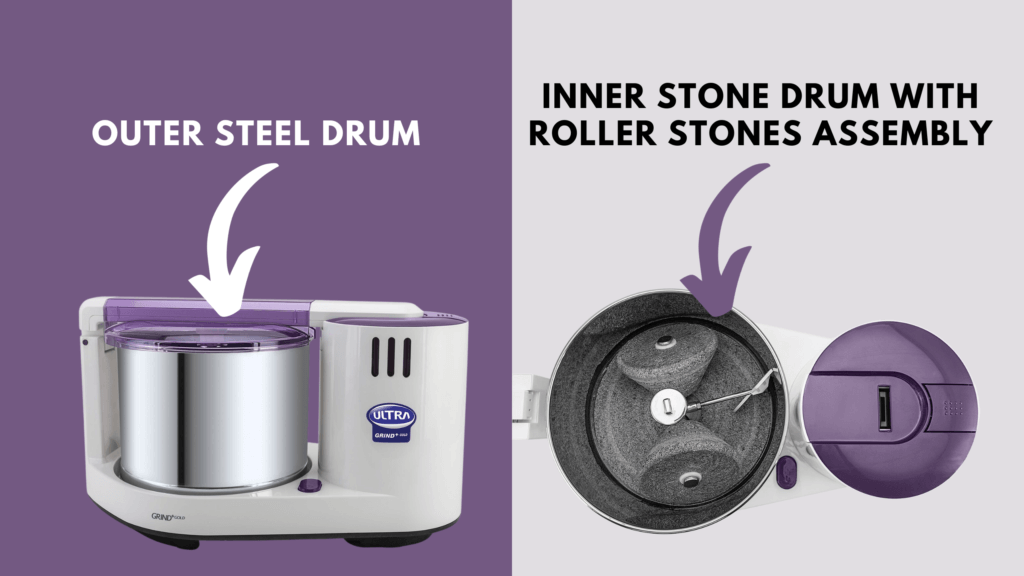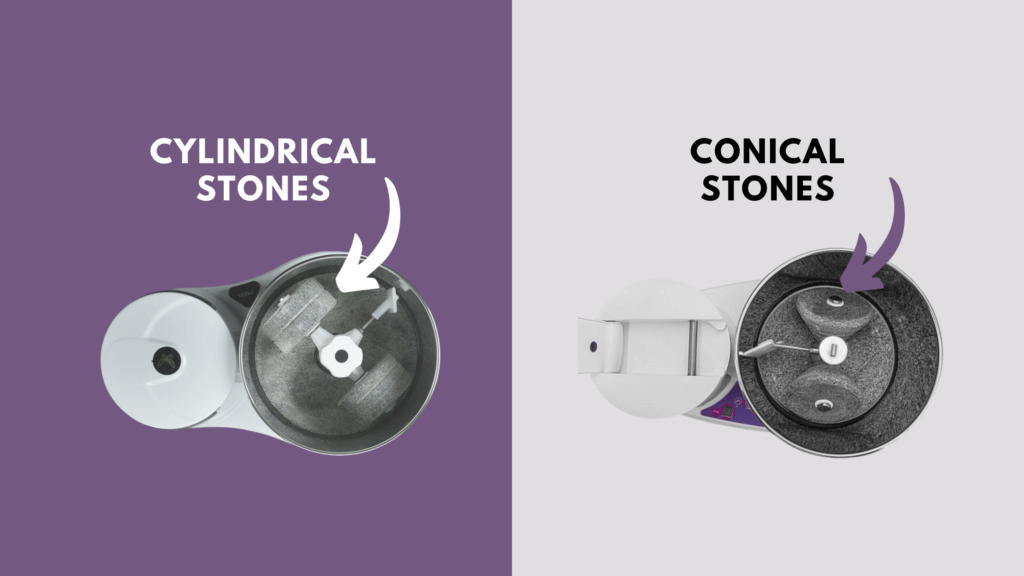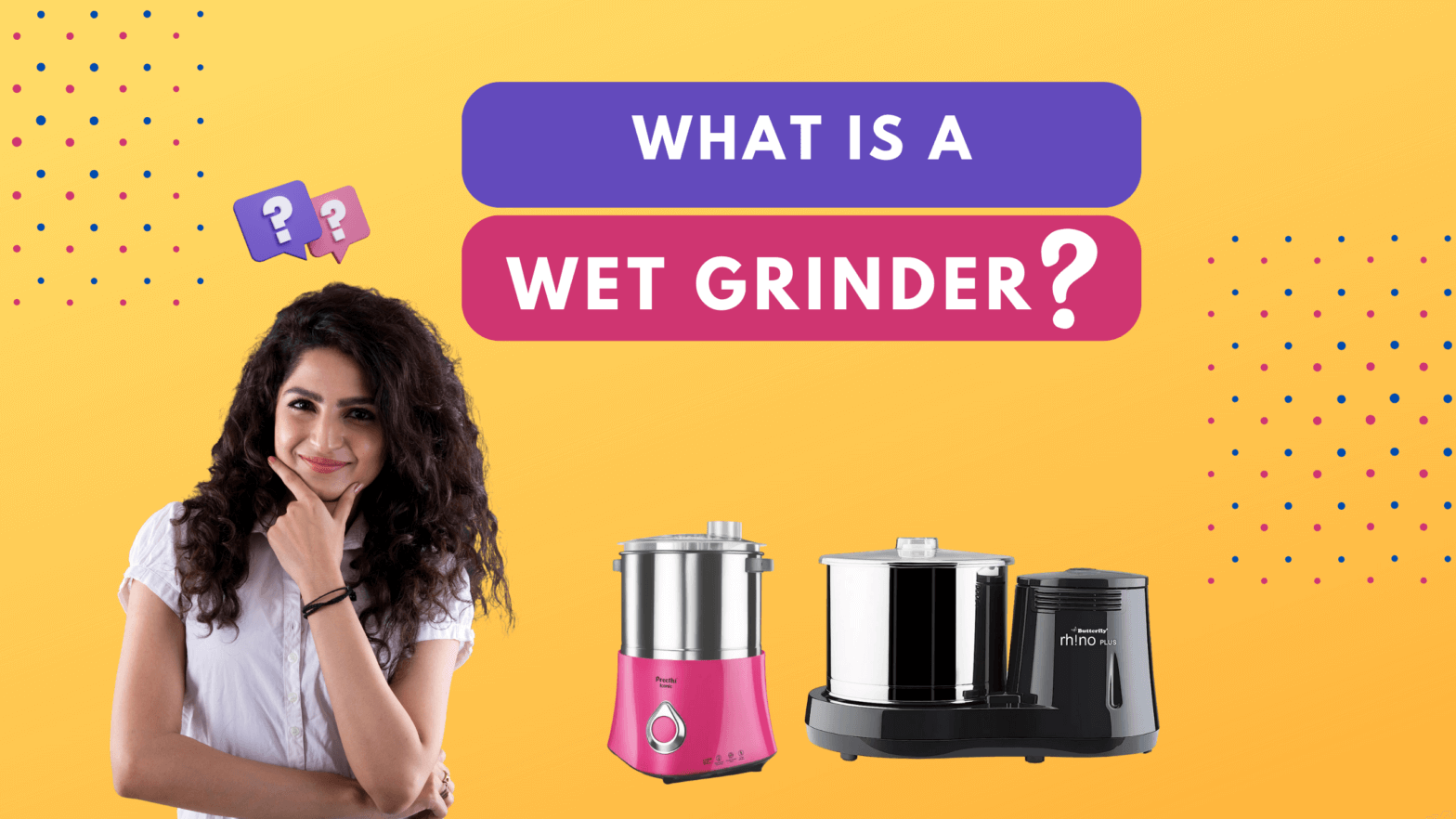What is Wet Grinder? A Comprehensive Guide
Synopsis
A wet grinder is a specialized kitchen appliance that uses grinding stones within a rotating drum to transform soaked grains and lentils into finely textured batters and pastes, used for traditional South Indian dishes like dosa and idli.
- Synopsis
- Introduction
- The Wet Grinder Defined
- Different Components of a Wet Grinder
- Types of Wet Grinders
- What Is Wet Grinder Used For?
- Wet Grinder Working Principle
- What Is Wet Grinder vs. Mixer Grinder
- At a Glance – What Is Wet Grinder vs. Mixer Grinder?
- Additional Resources
- Wet Grinder Buying Guide
- Maintenance and Care of a Wet Grinder
- Conclusion
Introduction
In the bustling world of culinary gadgets, one appliance stands out for its versatile, traditional, and essential role in the kitchen—the wet grinder.
If you’ve ever wondered what a wet grinder is and what it’s used for, you’re in the right place.
In this comprehensive blog post, we’ll take a deep dive into this humble yet remarkable kitchen companion.
We’ll explain what a wet grinder is, how it works, what it’s used for, and even how it compares to the popular mixer grinder.
So, let’s embark on this journey to unveil the secrets of the wet grinder.
The Wet Grinder Defined
A wet grinder is a kitchen appliance with a rotating drum and grinding stones designed for efficiently grinding soaked grains and lentils into smooth batters and pastes.
This is commonly used for preparing batters for South Indian dishes like dosa, idli, and vada.

A Brief Historical Perspective: Wet grinders have a rich history that dates back centuries.
Their evolution reflects the culinary traditions of different cultures, from ancient India to Southeast Asia and beyond.
The traditional stone grinder has evolved into modern variations, but the core concept remains the same.
Different Components of a Wet Grinder
To understand how a wet grinder works, it’s essential to dissect its components.
1. Grinding Stones: These are the heart of the machine, and are usually natural stones. They rotate and crush the soaked grains or lentils, creating a consistent texture.
2. Motor: The motor powers the grinding stone assembly. Its power capacity varies depending on the type and size of the wet grinder. A powerful motor is essential for efficient grinding.
3. Drum: This is where you place the ingredients to be ground. Drums come in various sizes to suit different needs. A larger drum is suitable for commercial purposes, while smaller ones are ideal for home kitchens.
It uses water to aid in grinding.
Types of Wet Grinders
Wet grinders come in several types, each designed for specific needs.
1. Tabletop Wet Grinders: These are compact and ideal for home kitchens. They are easy to store and offer sufficient capacity for most home cooking needs.
2. Tilting Wet Grinders: They have a tilting mechanism to pour out the batter conveniently. Tilting wet grinders are commonly used in restaurants and professional kitchens.
3. Commercial Wet Grinders: Larger and more powerful, these are used in restaurants and catering businesses. They are designed to handle heavy-duty grinding.
And lately, a new innovative variant of wet grinder is also available in the market – the one with a batter dispenser.
This is essentially a tabletop wet grinder introduced by SmartFingers (a registered trademark of M/s. Mayura Appliance, Coimbatore, Tamil Nadu) that comes with the convenience of a batter dispenser.
With this unique dispenser, you can effortlessly collect your freshly ground batter in a clean and hands-free manner.
You can read about this remarkable wet grinder in our detailed post – SmartFingers Wet Grinder Review.
What Is Wet Grinder Used For?
Wet grinders have an impressive range of applications:
1. Traditional Dishes: From dosa to idli, vada to appam, many South Indian dishes rely on wet grinder-ground batters. The consistent texture achieved with wet grinding is essential for these recipes.
2. Versatility: Besides batters, many wet grinder models come with an atta kneader and coconut scraper attachments.
3. Healthy Cooking: Batters made using a wet grinder retain more nutrients compared to those prepared using a mixer grinder. It’s a healthier way to prepare dishes as it preserves the natural flavors and nutrients of the ingredients.
Wet Grinder Working Principle
Ever wondered how this appliance works its magic? The wet grinder operates on a simple principle: the grinding stones rotate inside a drum filled with soaked rice or lentils.
The Role of Water: The addition of water is crucial as it helps to attain the desired consistency. This also prevents keeping the temperature of the batter low which can affect the quality of your batter or paste.
What Is Wet Grinder vs. Mixer Grinder
Wet grinders and mixer grinders are often compared, but they serve different purposes.
Let’s delve deeper into this comparison to help you understand when to reach for a wet grinder and when a mixer grinder is the better choice.
Distinct Functions:
- Wet Grinder: Master of Wet Grinding Wet grinders excel in one specific task: wet grinding. They are specially designed to transform soaked grains, lentils, and other ingredients into smooth batters and pastes. The primary function of a wet grinder is to achieve a consistent, fine texture that is vital for traditional South Indian recipes like dosa, idli, and vada.
- Mixer Grinder: Versatile All-Rounder Mixer grinders are versatile workhorses in the kitchen. They can perform a wide range of tasks, including blending, chopping, grinding dry spices, making smoothies, and even kneading dough. Mixer grinders are the go-to appliance for daily cooking needs, and they can handle both wet and dry grinding.
Unique Applications:
- Wet Grinder: Traditional Dishes and Specialty Batters Wet grinders are indispensable for recipes that require soaked grains and lentils. They are a must-have for traditional South Indian dishes where the texture of the batter is critical. The slow, consistent grinding process ensures the desired results.
- Mixer Grinder: Everyday Convenience Mixer grinders are your partners in daily cooking. They can quickly whip up chutneys, grind dry spices, make fruit juices, and blend smoothies. They are ideal for tasks like preparing ginger-garlic paste, tomato puree, or grinding spices for your everyday curries.
Texture and Consistency:
- Wet Grinder: Superior Texture When it comes to achieving a perfect, silky-smooth consistency, wet grinders have the upper hand. They maintain a low grinding temperature, resulting in batters and pastes with a fine, uniform texture.
- Mixer Grinder: Varied Textures Mixer grinders offer flexibility in texture. Depending on your needs, you can control the coarseness or fineness of the grind. This adaptability is particularly useful when you need coarse textures like for meat mincing or a slightly chunky salsa.
Health Benefits:
- Wet Grinder: Nutrient Preservation Batters prepared in a wet grinder are healthier than those made using a mixer grinder. It preserves the natural flavors and nutrients of the ingredients, making it a healthier choice for certain dishes.
- Mixer Grinder: Quick and Convenient Mixer grinders are designed for efficiency and convenience. While they may not preserve as many nutrients due to the higher heat generated during dry grinding, they are perfect for busy households and quick meal preparations.
Maintenance:
- Wet Grinder: Careful Maintenance Required Wet grinders require regular cleaning and meticulous care to prevent the buildup of residues and ensure the longevity of the grinding stones.
- Mixer Grinder: Easier Maintenance Mixer grinders are relatively easier to clean and maintain, making them a practical choice for those with busy schedules.
Conclusion: Choosing the Right Appliance
In conclusion, the choice between a wet grinder and a mixer grinder depends on your culinary needs and preferences.
- If you regularly prepare traditional South Indian dishes that require smooth batters and pastes, investing in a wet grinder is a wise choice.
- On the other hand, if you seek versatility and need an all-in-one appliance for various cooking tasks, a mixer grinder is your kitchen’s multitool.
Ideally, many kitchens have both appliances, allowing for a wider range of culinary possibilities.
At a Glance – What Is Wet Grinder vs. Mixer Grinder?
This table provides a quick overview of the key differences between wet grinders and mixer grinders, helping you choose the right appliance for your specific culinary needs.
| Aspect | Wet Grinder | Mixer Grinder |
|---|---|---|
| Distinct Functions | Ideal for wet grinding, making batters and pastes. It often comes with an atta kneading and coconut scraping attachment. | Versatile, suitable for blending, chopping, dry and wet grinding, dough kneading, and more |
| Unique Applications | Essential for traditional South Indian dishes; ensures fine texture | Convenient for daily cooking needs, offering versatility in tasks |
| Texture and Consistency | Achieves a fine, uniform texture due to low grinding temperature | Provides flexibility in texture control for various culinary needs |
| Health Benefits | Preserves more nutrients due to the wet grinding method | Efficient for quick meal preparations |
| Maintenance | Requires careful maintenance for grinding stones | Relatively easier to clean and maintain |
| Ideal For | Traditional recipes like dosa, idli, vada | Daily cooking tasks, including blending, chopping, mixing, and grinding |
RELATED READING
Additional Resources
✅More Resources To Help You!
Wet Grinder Buying Guide
Factors to Consider When Purchasing a Wet Grinder
Size and Capacity
- The size and capacity of the wet grinder should match your cooking needs. Consider the number of people you’ll be cooking for regularly.
Motor Power
- The motor’s power determines the efficiency of grinding. Higher power is preferable for quicker and smoother grinding, especially for larger quantities.
Type of Grinding Stones

- Choose between conical or cylindrical grinding stones.
- Conical Stone: Ideal for grinding softer ingredients like rice and urad dal. It produces smoother batters.
- Cylindrical Stone: Suited for grinding tougher ingredients like spices and grains.
- When selecting a stone, consider the type of cooking you do most often.
TIP
Elgi Ultra wet grinders usually come with Conical Stones and Butterfly wet grinders usually come with Cylindrical Stones.
Ease of Maintenance
- Look for models with features that make cleaning and maintenance hassle-free. Detachable parts and easy-to-clean designs are advantageous. You can even go for the one with a batter dispenser. Read about this remarkable wet grinder in our detailed post – SmartFingers Wet Grinder Review.
Price Range
- Wet grinders come in various price ranges. Determine your budget and prioritize essential features to find the best value for your investment.
Tips for Finding the Best Wet Grinder for Your Kitchen
- Consider brands with a reputation for quality and customer support.
- Check for warranty and after-sales service availability.
- Compare features, such as additional attachments or settings, that may enhance your cooking experience.
RELATED READING
Maintenance and Care of a Wet Grinder
Proper Cleaning and Maintenance
- After each use, unplug the wet grinder and let it cool before cleaning.
- Remove the grinding stones assembly and the drum for thorough cleaning.
- Use a soft brush or damp cloth to clean the exteriors and crevices.
- Avoid using abrasive materials that could damage the grinder’s surfaces.
Tips for Extending the Lifespan of Your Wet Grinder
- Ensure that the drum and grinding stones are completely dry before reassembling.
- Lubricate moving parts (if applicable) according to the manufacturer’s recommendations.
- Store the wet grinder in a cool, dry place to prevent rust or corrosion.
- Regularly inspect power cords and plugs for any signs of wear or damage.
- Adhere to the manufacturer’s maintenance schedule, including stone replacement if needed.
Troubleshooting Common Issues
- If the motor is overheating, give it a rest to cool down before continuing.
- In case of unusual noises or vibrations, check for loose parts or foreign objects in the drum.
- If the grinder fails to start, ensure it’s properly plugged in and the power switch is on.
- For consistent batter quality, maintain a consistent water-to-ingredient ratio and follow recommended soaking times.
Following these buying tips, maintenance guidelines, and troubleshooting steps will help you make the most of your wet grinder, ensuring it serves you well for years to come.
Conclusion
In conclusion, a wet grinder is not just a kitchen gadget; it’s a gateway to a world of delectable South Indian dishes.
With its historical significance, simple yet effective design, and versatility in the kitchen, it has earned its place as an essential appliance.
So, if you want to elevate your culinary game and explore authentic recipes, consider adding a wet grinder to your kitchen arsenal.
Happy cooking!
✅More Resources To Help You!
About Author
You can ‘meet your author’ on the About Author page here.
